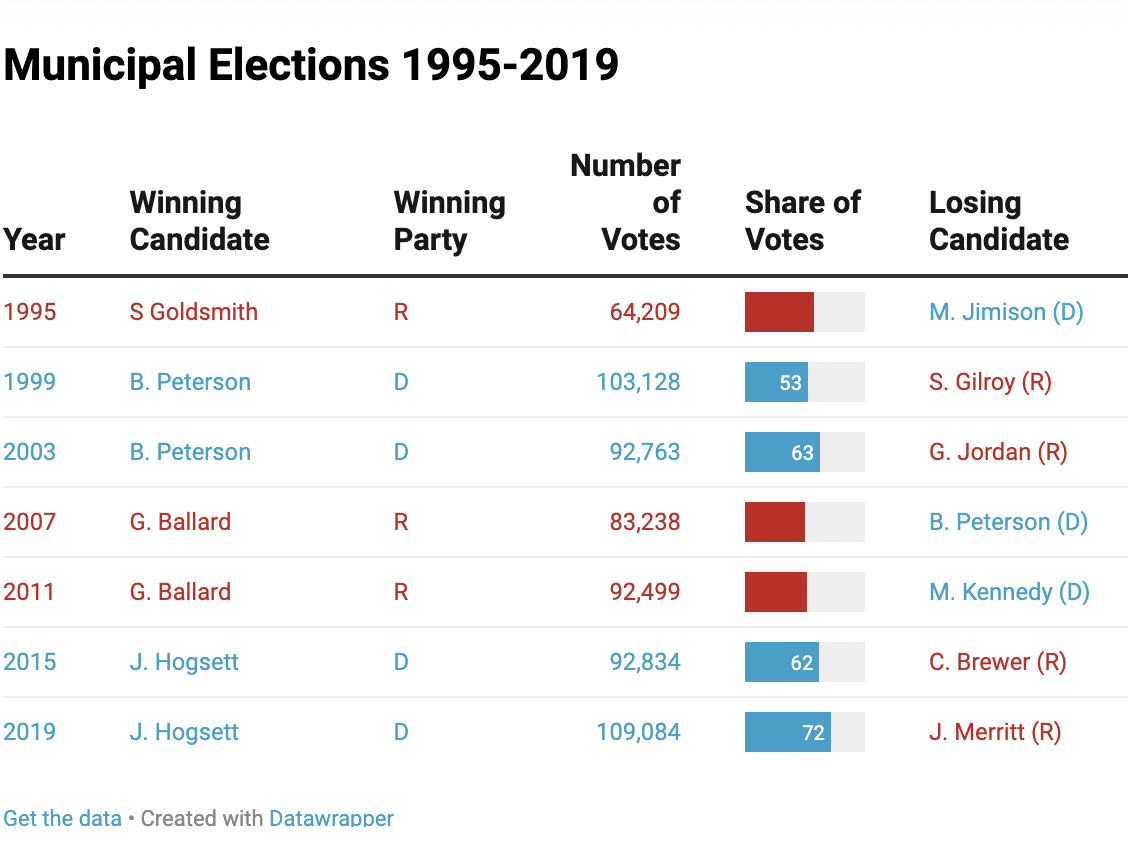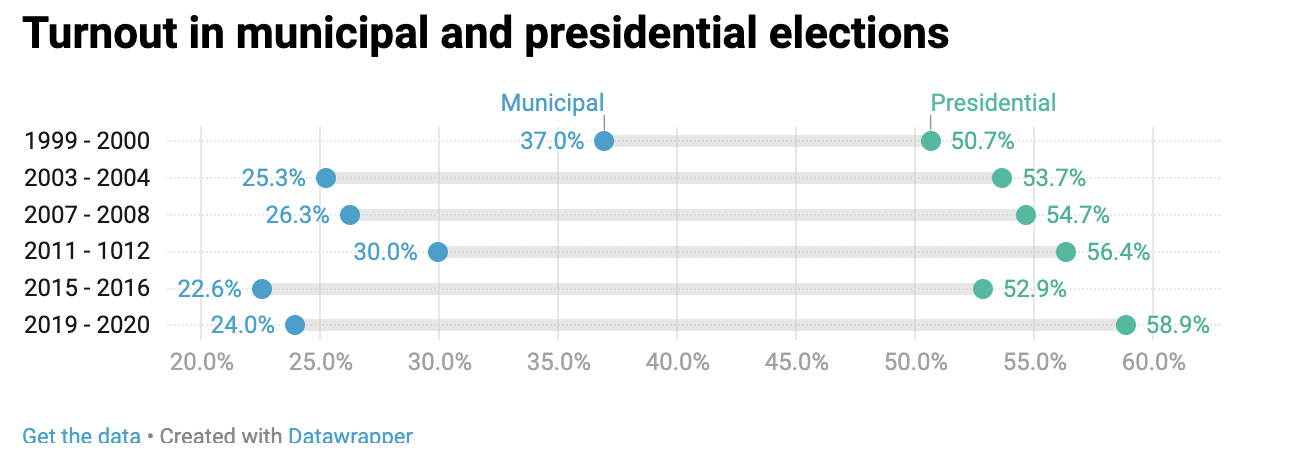The 1969 reorganization of Indianapolis-Marion County local government known as Unigov had profound effects on patterns of political participation and political influence within the county.

Some of those effects clearly were anticipated; others may not have been. The three most distinctive and immediate results included the dominance of the in local elections, the decline of political influence of the African American community, and an overall decline in voter participation rates as measured by registration and election turnout.
Partisanship has governed Indianapolis politics since the Civil War. Accordingly, the most frequently discussed effect of the Unigov reorganization on local politics has been its shift in the balance of power between Republicans and Democrats. Unigov was born of Republican victories in the city, county, and state elections of 1967 and 1968. Its enabling legislation passed both chambers of the Indiana General Assembly on essentially party-line votes. The partisan Republican motivation associated with Unigov could be seen in both the Democrats’ nickname for the reorganization—”Unigrab”—and by a comment made at the time by Marion County Republican Party Chairman . Referring to Unigov’s expansion of the Indianapolis electorate from 293,371 to 406,155 registered voters, Bulen rejoiced, “It’s my greatest coup of all time, moving out there and taking in 85,000 Republicans.”
Prior to 1969, elections for municipal and county offices usually were strongly contested and victory margins narrow, but the results fell into a distinctive pattern. Democrats typically won Indianapolis city races, and Republicans prevailed in county and suburban contests. The “normal Democratic vote” in the pre-Unigov city of Indianapolis was estimated to be about 57 percent at the end of the 1960s, so Republican candidates faced uphill battles in elections for and the , which was elected at large.
Unigov fulfilled Republican hopes for a change in this electoral pattern. In the 20 years before Unigov reorganization took effect on January 1, 1970, Democrats won 3 of 5 office-of-the-mayoral contests and elected majorities to the Common Council in four of those five elections. In the 50 years after Unigov, Republicans won the mayor’s office in 9 of 13 municipal elections, many of which resulted in Republican majorities on the City-County Council. Republican victories in some of the mayors’ races have been lopsided, and Republican majorities on the have been overwhelming until the early 2000s. Through its enlargement of the municipal electorate to include all county voters, Unigov converted a substantial Democratic edge in Indianapolis elections into a decided Republican advantage.

The Marion County , seriously debilitated from the 1970s until 1999, found it difficult at times to offer formidable challengers for local offices, including that of the mayor. Only a resurgence of Democratic strength at the state level prompted a rebound of Democratic electoral prospects in Marion County later in the 1990s. By contrast, the Marion County Republican Party thrived through the 1970s into the 1990s, presenting one of the nation’s few remaining likenesses to an “urban political machine.” The first post-Unigov Democratic mayor, Bart Peterson, was elected in 1999 and partnered initially in governing with a Republican-controlled City-County Council, led by President Bert SerVaas.
At times, the Republican party’s post-Unigov success brought allegations of insensitivity and “arrogance of power.” Such charges came into sharpest focus in 1986 when a court order was necessary to halt the practice of City-County Council Republicans taking votes on budgetary and other important matters in closed party caucuses, in clear violation of the state’s “Open Door” law. Some observers of local politics have also commented on a lack of public debate and dissent and a rather exclusive character to local government decision-making. On the other hand, the stability of political leadership in Indianapolis under Unigov may account to some degree for the city’s success in promoting economic development and attracting investment during two recessionary decades, at least as experienced by other northern and Midwestern cities.
In Indiana, political conflict occurs primarily between political parties, and Unigov’s effect on the political interests of Indianapolis’ African American residents must be viewed in terms of its impact on the two major parties. Many Black residents opposed Unigov because adding predominately white suburban county voters to the city electorate would dilute Black voting strength. At the time, approximately 87 percent of all Black Marion County residents lived in the core of pre-Unigov Indianapolis. Enlarging the city’s boundaries added relatively few African Americans but nearly a quarter of a million whites. Some observers saw this as a step backward for the city’s African American constituency. The proportion of Black residents had grown from 15 percent of Indianapolis’ population in 1950 to 21 percent in 1960 to about 27 percent in 1969. Following the Unigov expansion, the 1970 census showed an African American population of approximately 18 percent, a figure of pre-1960 proportions. In the ensuing decades, Black population grew to comprise approximately 22.3 percent of the 1990 population; 25.5 percent of the 2000 population; 27.5 percent of the 2010 population; and approximately 27 percent of the 2020 population.
The more important effect of Unigov on Black political influence was the shift in the balance of power between the two major parties. Even at the 1969 proportion of 27 percent, African Americans were a decided minority of the city population. However, given Blacks’ overwhelming identification with the Democratic party, that percentage was fast approaching half of the city’s “normal Democratic vote” of 57 percent. Thus, heavy Democratic votes in Black wards occasionally proved decisive in city elections and continue to do so well into the 2000s.
Given the Black constituency’s high level of voting cohesion, African Americans in Indianapolis in 1969 were on the verge of becoming the base vote of the city’s majority party. After Unigov, Indianapolis Blacks had only minority status within a minority party, a party that proved unable to win a mayoral race or a council majority for the next 30 years. That finally occurred in 1999 when Bart Peterson became the first Democratic mayor elected since 1963.
Unigov reorganization arguably had some important beneficial effects for Indianapolis’ African American residents. Changes in the selection of council members provided them with a more direct role in electing municipal representatives. Prior to Unigov, the at-large system of electing members of the city’s Common Council left Blacks dependent on local party organizations to slate enough African American candidates to ensure the election of at least one. With the arrival of Unigov, the 29-member City-County Council was composed of 25 single-member districts plus four at-large seats. Several of the 25 single-member districts contained enough Black majorities, which made the election of African American council members more probable. Even the most creative efforts to draw 25 City-County Council districts cannot avoid producing several predominantly Black districts.
In November 2007, Republican Gregory A. Ballard, a former Marine with no political or government experience, defeated Bart Peterson’s run for a third term. With Ballard’s victory, the Council returned to Republican control. The Democrats regained control of the Council in the next election cycle, resulting again in divided government. This was the cycle that brought the first woman—Maggie Lewis—ever elected as council president. She was not the first African American to serve in that capacity since moved from Minority Leader to President of the Council in 2003 as a result of the change to Democratic control of the Council. After Boyd, every Democratic Council President—Monroe Gray, Steve Talley, Maggie Lewis, Stephen J. Clay, and Vop Osili—have been African American.
In 2013, the Republican-controlled Indiana General Assembly abolished the at-large City-County Council seats in an effort to further undermine growing Democratic strength in the city. Ultimately, it has not succeeded as Democrats have retained control since 2011.
Supporters of Unigov also argued that Indianapolis’ African Americans would benefit from the broader tax base that accompanied the incorporation of wealthier suburban areas into the city. But Unigov excluded from city-county control two of the key services—public education and welfare—upon which lower-income (and disproportionately Black) Center Township residents depended. Unigov did not broaden the tax base for either the township poor relief system or . At the same time, other services on which residents of the “old city” depended—police and fire protection, and sanitation—were brought into Unigov departments under the direction of the then Republican mayor and council, while their tax bases remained fixed within the limits of their respective . In 2007, state legislation allowed the merger of the Indianapolis Police Department and law enforcement officers of the Marion County Sheriff’s Department to create the , which expanded law enforcement countywide. Similarly, legislation allowed township fire departments to merge voluntarily with the .
Apart from Unigov’s intended effect on the balance of power between the two major parties is the question of its effect on political participation rates. One of the charges directed toward the pre-Unigov structure of local government was that its excessive complexity and insufficient accountability frustrated and turned off voters—a charge crystalized in the 1959 pamphlet, Who’s in Charge Here? By implication, Unigov’s consolidation of political leadership in a strong mayor and council was supposed to restore accountability and reawaken the electorate’s interest in their local government. Comparison of pre-Unigov and post-Unigov voting turnout percentages in municipal or county election years do not offer much support for either conclusion. Local government’s pre-Unigov complexity did not diminish voter involvement, nor have Unigov’s clearer lines of governmental authority encouraged greater voter participation. The percentage of the voting-age population participating in municipal elections has held steadily in the mid to upper 20 percentile range since 2000.
Whatever Unigov’s effects on the service delivery and public finances in the city of Indianapolis, the effects on political participation have been and remain controversial. At a minimum, the comparison of the 20 years prior to Unigov with the 50 years since reveals that party competition has ebbed and flowed over time, with each major political party enjoying control at various intervals though with Republicans dominating in the first three decades of consolidation. While there has been a drop in voting turnout in municipal elections in Marion County, election experts have attributed that to various factors including lack of interest in “off” year/non-presidential elections, continued lack of understanding of how local government works and impacts citizens’ lives, as well as potential efforts to tighten restrictions on voter participation.

Help improve this entry
Contribute information, offer corrections, suggest images.
You can also recommend new entries related to this topic.